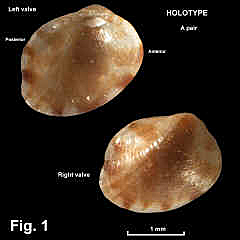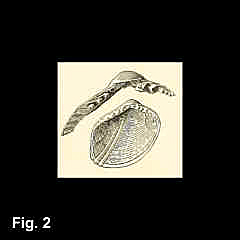|
|
PHILOBRYIDAE |
|
|
|
Lissarca picta (Hedley, 1899) Description: Shell minute. No prodissoconch. Shape obliquely subquadrate, inflated, angled along a line from umbo to posterior ventral margin; umbo at about one-third of total length from anterior end. Anterior end smoothly rounded, posterior end truncate, indented, ventral margin smoothly rounded. Hinge line arched, with 3 strong teeth on posterior side, a central zone, and 2 strong teeth on anterior side. Central zone with very fine elongate denticles and a central triangular ligament pit. Interior with adductor muscle scars well defined, external ribs showing through; margin denticulate below hinge on both sides. Exterior smooth or with irregular concentric ridges; 2 or 3 radial ribs from umbo to ventral posterior margin, visible internally. Periostracum not apparent. Shell colour variable, usually mottled with brown on fawn background. Size: Up to 2.2 mm in length. Distribution: Known from Port Stephens, NSW, southwards and around southern Australia, to SA, including Tas. Habitat: Most specimens are from beach washup. Comparison: This species is more quadrate and pigmented in comparison to Lissarca elliptica which is rounded and always unpigmented. Synonymy: Lissarca rhomboidalis Verco, 1907 is a synonym (NEW SYNONYM). The paratypes of L. rhomboidalis were compared with the holotype of L. picta and found to match it in size, shape and habitat. The holotype of L. picta is strongly coloured, as the name suggests, but the paratypes of L. rhomboidalis are white. Verco noted that dead shells fade to white. Fig. 1: HOLOTYPE Balmoral, Middle Harbour, Sydney, in sand. (C.006378). Fig. 2: Hinge detail. From Hedley (1899) Proceedings of the Linnean Society of New South Wales, 24: 429-434, fig. 1. |
|

